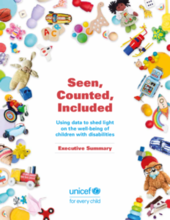In 2015, the adoption of the 2030 Agenda for Sustainable Development was framed around the pledge of leaving no one behind. It calls for a commitment to ensure that all 17 Sustainable Development Goals (SDGs), comprising 169 targets, are achieved for the benefit of all members of society. It emphasizes reaching those furthest behind first, which inevitably includes children with disabilities and their families.
Monitoring the inclusion of children with disabilities in development efforts has long been held back by the lack of reliable and comprehensive data. Recent years, however, have seen renewed efforts to fill data gaps. The development of new data collection tools has resulted in a substantial increase in the availability and quality of data on children with disabilities, fostering new analyses and contributing to increased knowledge generation.
This report is a testament to these efforts. It offers evidence crucial to decision-making to fulfill obligations, both moral and legal, to give every child an equal chance in life. The largest compilation of statistics on children with disabilities to date, it builds on data from more than 1,000 sources. It documents the scale and characteristics of children with disabilities and begins to shed light on the types of adversity they often face. It includes internationally comparable data from 43 countries and areas and covers more than 60 indicators of child well-being – from nutrition and health, to access to water and sanitation, protection from violence and exploitation, education and life satisfaction. It also presents global and regional estimates of children with disabilities, drawn from data from over 100 countries.
The report’s objective is to promote the use of these data to make children with disabilities more visible, bringing about a fuller understanding of their life experiences.

